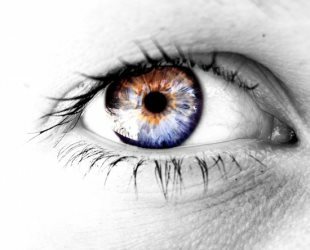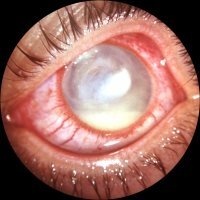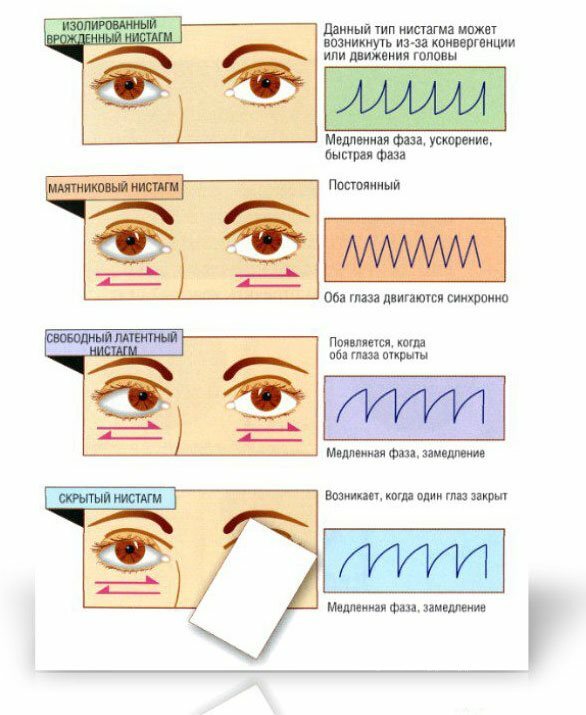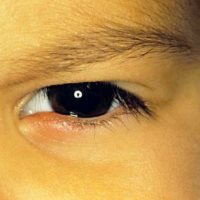
Nystagmus is an oscillatory movement of eyeballs that a person can not control. Movement can be both physiological and pathological.
So, if in normal vision you are moving around the room, focusing on one subject, your pupil will move. And if we talk about involuntary movements of the pupil, then this is already a disease.
Nystagmus of motor imbalance is formed due to primary defects of efferent mechanisms.
Congenital nystagmus is formed at the 15-20 week of pregnancy and manifests itself only in 2-3 months of life of the baby. According to statistics to date, one in ten thousand babies is born with a nystagmus.
Reasons:
- cataract;
- trauma to eyeballs;
- heredity: Leber's amaurosis and albinism;
- of the brain disease;
- poor vision;
- retinal dystrophy;
- diseases of the central nervous system;
- effects of drug poisoning.
Most often, the appearance of nystagmus is associated with a decrease in vision during adolescence.
To the physiological type is customary to attribute the following:
- drifting motion;
- tremor;
- drastic changes that fall into the field of view of the side view;
- shallow, not expressed jumps, characteristic at supervision for high-speed objects.

The analysis of eye diseases continues, read further - the symptoms of keratitis, its diagnosis and proper treatment.
How can I quickly reduce eye pressure? In the note of the ophthalmologist( link) the most popular solutions to this problem.
Pathological nystagmus in children and adults can be:
- ophthalmic, which is characterized by acquired at an early age or congenital visual impairment, or pathological abnormalities in the functioning of the visual apparatus, which are congenital in nature;
- is neurogenic, or central, which can be caused by lesions of the vestibular component of the oculomotor system.
To detect such oscillatory movements is very simple: you just need to put your finger at a distance of 20-30 centimeters in length and 10-15 cm in the side.
There are three types of nystagmus in general:
- jerky - it includes slow defoevating movement and fast correcting reflex movement. Oscillations also differ in speed;
- undulating, or pendulum-like - equal in magnitude oscillation phases
- mixed type - includes signs of both jerky and pendulum-like nystagmus;
Depending on the direction of motion, the following are distinguished:
- vertical;
- rotary;
- is diagonal;
- horizontal.
Physiological nystagmus is a jerky nystagmus that is characterized by the appearance of vibrational movements of the eyeballs due to changes in pressure in the vestibular nuclei.
So, for example, if you pour cold water into the right ear, then in the right eye will begin horizontal non-derivative movements. If the left - then the left eye.
Latent nystagmus - the appearance of oscillations with closed or semi-closed eyes. Usually caused due to fatigue and increased pressure in the eyes.
Setting nystagmus - jerky little oscillations with maximum dilution of the pupil to the side.
Nystagmus motor imbalance - includes all of the above characteristics and is formed due to the weak tone of the oblique muscles of the eyeball.

Nystagmus sensory deprivation
It is formed due to visual acuity violation. There are both horizontal and vertical oscillations, as well as visual acuity decreases. The reason for the nystagmus of sensory deprivation is the severe disruption of central vision at a fairly early age. Most often nystagmus develops in children aged two years.
Recurrent nystagmus
With this type of nystagmus, the eyes are divorced during the oscillatory movements in opposite directions. Most often this is due to the presence of parasellar tumors, which in turn cause a bitemporal hemianopsia.
Symptoms:
- forced head rotations to reduce eye strain;
- cornea does not perceive the sun's rays, resulting in a person developing photophobia;
In general, with a detailed examination, the doctor can determine the presence or absence of this disease in the child. Electroretinograms are used for computer diagnostics.
The basis for the classification is also the magnitude of the oscillations: if the amplitude of the oscillations is more than 15 degrees, it is a large-caliber nystagmus, from 5 to 15-the average caliber, not reaching 5 degrees, is small-caliber.
Not always nystagmus is a disease. So, for example, in normal people with healthy eyesight, one can easily develop an optokinetic nystagmus. It is quite normal action, since it is the reaction of the eyes to moving objects. Labyrinth nystagmus can begin any minute at any person because of an overstrain of eye muscles. This variety is different in that it has only horizontal character. Also, the reaction of the eyes can easily begin at the extreme pointing of the eyes to the side.

A purulent balloon has erupted for a century? You should pay attention - how to treat barley on the eye, a detailed description of the disease, its diagnosis and prevention.
In the article, the symptoms of a nasty disease are demodectic eyelids. Symptoms of retinal angiopathy!http: //moezrenie.com/bolezni/ zabolevaniya-setchatki / angiopatiya-setchatki-glaza.html
Treating
Treating nystagmus is very difficult and long. Not always even the longest work leads to success or even minor changes. Treatment in the main measure consists of eliminating the original cause. To improve muscle tone and visual acuity, it is good to use reflexotherapy, keratoplasty.

Drug treatment consists in the appointment of various medical vasodilator drugs. Assign also vitamin and semi-vitamin complexes, which strengthen the whole body as a whole.
Along with this, doctors advise wearing glasses and lenses. It is best to stop your choice on the lenses, because when you move the eyeball, the lens will always remain on the eye.
Surgical treatment of nystagmus
This radical treatment is carried out to reduce the vibrational movements of the eyes. The purpose of this operation is to transfer the rest zone from the middle position. To achieve this, you need to weaken some muscles, and some, on the contrary, to strengthen.
Thus, in addition to the fact that a person is cured of uncontrolled oscillatory movements, so also gets excellent vision. After the surgical interventions the patient straightens the position of the head, the photophobia disappears.
Video:
Look at the look of how the nystagmus looks.
